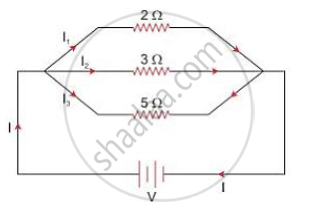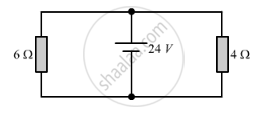Advertisements
Advertisements
Question
You have three resistors of values 2Ω, 3Ω and 5Ω. How will you join them so that the total resistance is less than 1Ω? Draw diagram and find the total resistance.
Solution
The three resistors should be connected in parallel
To get a total resistance less than 1Ω

In parallel, if the equivalent resistance is RP, then
`therefore 1/R_p = 1/R_1 + 1/R_2 + 1/R_3`
`therefore 1/R_p =1/2+1/3+1/5`
`therefore 1/R_p = (15+10+6)/30`
`therefore 1/R_p = 31/30`
⇒ `R_p = 30/31 = 0.97 Ω`
APPEARS IN
RELATED QUESTIONS
Complete the following :-
(c)

What are the advantages of connecting electrical devices in parallel with the battery instead of connecting them in series?
Find the current in each resistor in the circuit shown below:

A 4 Ω coil and a 2 Ω coil are connected in parallel. What is their combined resistance? A total current of 3 A passes through the coils. What current passes through the 2 Ω coil?
If current flows through two lamps arranged:
(a) in series,
(b) in parallel,
and the filament of one lamps breaks, what happens to the other lamp? Explain your answer.
A battery of e.m.f. 15 V and internal resistance 2 `Omega` is connected to tvvo resistors of 4 ohm and 6 ohm joined.
(i) In series,
(ii) In para 1 lel. Find in each case the electrica I energy spent per minute in 6 ohm resistor.
Show how would you connect three resistors, each of resistance 6 O so that
the combination has a resistance of(a) 9 Ω (b) 4 .Ω
What are the advantages of a parallel connection?
The equivalent resistance of a parallel combination of two resistors of 30 Ω and 60 Ω is ______________.
You have three resistors of values 2 Ω, 3 Ω, and 5 Ω. How will you join them so that the total resistance is less than 1 Ω? Draw a diagram and find the total resistance.
